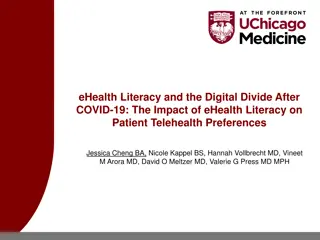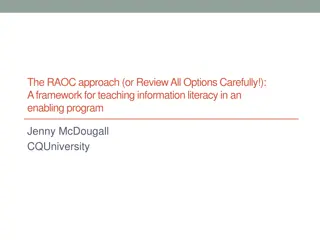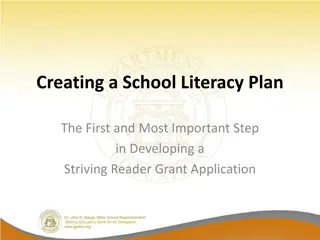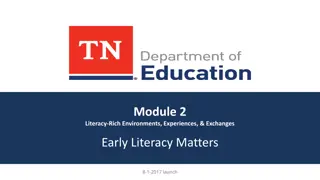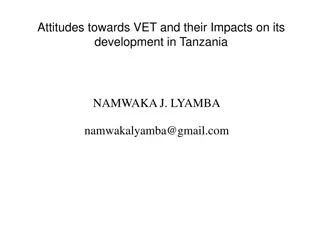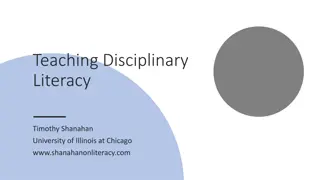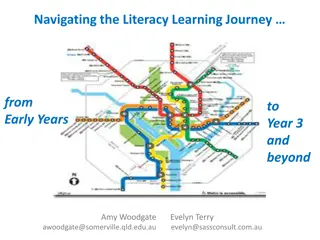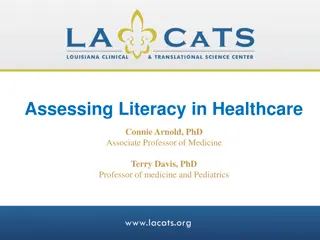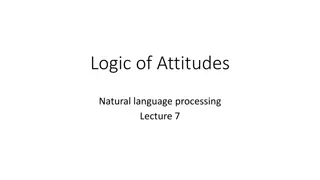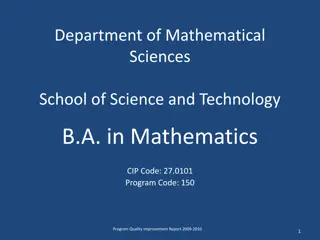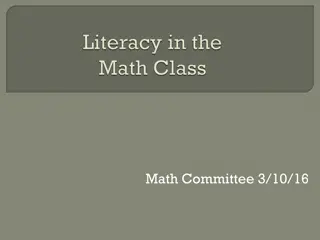Evolution of Mathematical Literacy and Attitudes in Educational Settings
Explore the transformation in attitudes towards mathematics in educational institutions, focusing on changes in course sequences, redesign goals, and the implementation of a new math literacy design. The shift includes a move towards data literacy, application-based learning, and integrating technology for improved student engagement.
Download Presentation

Please find below an Image/Link to download the presentation.
The content on the website is provided AS IS for your information and personal use only. It may not be sold, licensed, or shared on other websites without obtaining consent from the author. Download presentation by click this link. If you encounter any issues during the download, it is possible that the publisher has removed the file from their server.
E N D
Presentation Transcript
OUTCOMES FOR MATHEMATICAL LITERACY: DO ATTITUDES ABOUT MATH CHANGE? M A RTHA B. M A KOW S KI & ER I N W I LDI N G - M A RTI N N OVEM BER 19, 2015 A M ATY C 2015 S ES S I ON S 023
MATHEMATICAL LITERACY AT PARKLAND COLLEGE ERIN WILDING-MARTIN EMARTIN@PARKLAND.EDU
ALGEBRA AT PARKLAND Approximately 67-75% of incoming freshmen place into developmental math Success rates of about 50% in beginning, intermediate, and college algebra Approximately 75% of developmental math students are on a non-STEM path!
OLD COURSE SEQUENCE Gen Ed Math or Intro to Stat Beginning Algebra Intermediate Algebra Pre-Algebra College Algebra or Pre- Calculus
REDESIGN GOALS Create a new track for gen-ed bound students Keep core algebra content, add data literacy De-emphasize by-hand algebraic simplification Add more applications, exploration, and writing Use technology
COURSE SEQUENCE FIRST REVISION Intro to Statistics or Gen Ed Math Math Literacy Pre-Algebra Intermediate Algebra Beginning Algebra College Algebra or Pre-Calculus
COURSE SEQUENCE CURRENT VERSION Intro to Statistics or Gen Ed Math Math Literacy Pre-Algebra Intermediate Algebra College Algebra or Pre-Calculus
MATH LITERACY DESIGN Alternate but still challenging path Math in context, focus on numeracy, data analysis, and functions Develop critical thinking and conceptual understanding
THIS CLASS IS DIFFERENT! Little to no lecture Group work, active participation required Reading, writing, technology Online skills work outside of class
PROBLEM SOLVING SKILLS Collaboration as a tool for problem solving and thinking. Keep calm and carry on: Mathematicians don t know how to solve every problem immediately. They just know how to start thinking about it.
PRODUCTIVE STRUGGLE Real problems don t follow cookie-cutter patterns; they take work Take responsibility Persistence will pay off
GROUP STRUCTURE Assigning groups 3-4 students per group Mix of abilities Full participation required Students may not opt out of group work Points given for quality participation Assignments Daily lessons Unit projects
OUTCOMES: DO ATTITUDES CHANGE? M A RTHA M A KOW S KI UN I VER S I TY OF I LLI N OI S AT UR BA N A - CHA M PA I G N M M A KOW S 2@I LLIN OI S. EDU
QUESTION Do Mathematical Literacy students change their attitudes towards math while taking the class?
SURVEY STRUCTURE Surveyed twice: First week of the semester Once during the last two weeks of the semester Asked about: Math attitudes (pre and post) Preferred learning methods (pre and post) Nature of mathematics (pre and post) Demographics (pre) A few other things
SURVEY SAMPLE 96 students took the pre-survey 67 took the post survey (69.8% retention) Race Male Female Total White 23 (25.0) 29 (31.5) 52 (56.5) Black 19 (20.7) 10 (10.9) 29 (31.5) Hispanic 0 (0.0) 5 (5.4) 5 (5.4) Asian 0 (0.0) 5 (5.4) 5 (5.4) Other 1 (1.1) 0 (0.0) 1 (1.1) Total 43 (46.7) 49 (53.3) 92
MEASURED ATTITUDES Mathematical attitudes measured along 4 dimensions: Motivation (9 items) Value (8 items) Confidence (15 items) Enjoyment (8 items) Attitudes were measured with 5 point Likert scale items 5 = Strongly Agree 4 = Agree 3 = Neither agree nor disagree 2 = Disagree 1 = Strongly disagree
MATH ATTITUDES 4.5 4 3.5 3 2.5 2 1.5 1 0.5 0 Motivation Enjoyment Value Confidence Pre-survey mean Post-survey mean
THOSE KIND OF LOOK LIKE SMALL CHANGES .5 .5 .4 .4 .3 .3 Density Density .2 .2 .1 .1 0 0 1 2 3 4 5 1 2 3 4 5 pre_confid_sc post_confid_sc Pre-survey mean 2.822 2.919 3.734 2.869 Average difference (s.e.) 0.104 (0.063) 0.180 (0.071) 0.097 (0.059) 0.182 (0.085) p-value (diff 0) 0.1068 0.0143 0.1063 0.0366 Attitude Scale Motivation Enjoyment Value Confidence N 60 59 54 49 Post-survey mean 2.926 3.100 3.831 3.052
MATH ATTITUDES - DETAILS Attitude Scale Motivation Enjoyment Value Confidence Confidence Attitude Scale Motivation Pre-survey mean 2.822 Pre-survey mean 2.822 2.919 3.734 2.869 2.869 Post-survey mean 2.926 Post-survey mean 2.926 3.100 3.831 3.052 3.052 Average difference (s.e.) 0.104 (0.063) 0.180 (0.071) 0.097 (0.059) 0.182 (0.085) 0.182 (0.085) Average difference (s.e.) 0.104 (0.063) p-value (diff 0) 0.1068 0.0143 0.1063 0.0366 0.0366 p-value (diff 0) 0.1068 N* 60 59 54 49 49 N 60 Enjoyment 59 2.919 3.100 0.180 (0.071) 0.0143 Value 54 3.734 3.831 0.097 (0.059) 0.1063 So, significant, POSITIVE attitude changes for enjoyment and confidence! Positive attitude shifts for motivation and value, although not significant.
ATTITUDES: ADDITIONAL RESULTS Men had a significantly higher shift in motivation compared to their female counterparts. There were no significant differences in attitudes on the pre-survey between the students who took both surveys (almost-completers) to those who only took the first one (non-completers).
WHICH ATTITUDES CHANGED? 120.00 100.00 80.00 60.00 40.00 20.00 0.00 Motivation Enjoyment Value Confidence Negative Change No Change Positive Change
WHOSE ATTITUDES CHANGED? 21 of the 67 students who took both surveys increased their attitude on three or four of the scales (31.3%) 6 students decreased their attitudes on three or four of the scales (9.0%) Some students did not change their attitudes on some of the subscales.
NATURE OF MATH/LEARNING Pre- survey mean Post- survey mean Average diff (s.e.) N p-value Learning mathematics is mostly memorizing facts There is only one way to solve a mathematics problem I enjoy working in small groups in math class I learn mathematics best when I get to work in a group I learn mathematics best when I work by myself. The math I learn in school rarely helps me when I use math in my daily life. 63 3.000 2.937 -0.063 (0.128) 0.621 -0.424 (0.143) 66 2.379 1.955 0.004 64 3.656 3.719 0.063 (0.126) 0.621 66 3.515 3.455 -0.061 (0.151) 0.689 66 2.833 2.894 0.061 (0.140) 0.666 64 3.125 2.891 -0.234 (0.117) 0.050
NATURE OF MATH/LEARNING Pre-survey mean Post-survey mean Average diff (s.e.) p-value N Learning mathematics is mostly memorizing facts There is only one way to solve a mathematics problem I enjoy working in small groups in math class I learn mathematics best when I get to work in a group I learn mathematics best when I work by myself. The math I learn in school rarely helps me when I use math in my daily life. 63 3.000 2.937 -0.063 (0.128) 0.621 66 2.379 1.955 -0.424 (0.143) 0.004 64 3.656 3.719 0.063 (0.126) 0.621 66 3.515 3.455 -0.061 (0.151) 0.689 66 2.833 2.894 0.061 (0.140) 0.666 64 3.125 2.891 -0.234 (0.117) 0.050
THANK YOU! Come see our other talks! Making Math Literacy Work: Managing Groups and Student Expectations Student Experiences in a Problem-Centered Developmental Math Class S139 Research Session Saturday, November 21 10:45 11:35 Thursday, Nov 19 7:00-9:50 pm Erin Wilding-Martin & Brian Mercer Martha Makowski emartin@parkland.edu mmakows2@Illinois.edu
GENDER DIFFERENCES Average difference (s.e.) 0.283 0.276 0.211 0.148 Attitude Scale Motivation Enjoyment Value Confidence N: Male N: Female 22 24 21 22 p-value (diff 0) 0.030 0.057 0.082 0.392 38 35 33 27 (0.127) (0.142) (0.119) (0.171)
COMPLETERS VS. NON- COMPLETERS N: Pre-survey only* 28 27 24 25 N: Both pre- & post-survey* 62 63 61 57 Motivation Enjoyment Value Confidence * Each subscale was composed of multiple items for which a student needed complete data in order to have a valid subscale score. As a result, the sample size for each subscale varies depending on how many individuals had complete data on that subscale. Average difference (s.e.) p-value (diff 0) 0.261 (0.175) 0.236 (0.170) 0.052 (0.144) 0.363 (0.198) 0.1391 0.1682 0.7194 0.0707
COURSE EVALUATION ITEMS There were also a few evaluation items on both the pre-post surveys asking about previous math class experiences and about how they like the class. The first three questions were on the pre-survey; the rest were on the post-survey. Here, low scores (1 or 2) correspond with Agree and high scores (4 or 5) correspond with Disagree. Item statement In my previous math classes, the teacher usually lectured for most of the class period. In my previous math classes, we worked in groups almost every day. I liked how my previous math classes were taught. This course made me think about mathematics differently than I had before I enjoyed this course more than most of my prior math classes. I found the format of this class frustrating I would take another mathematics class that was taught the way this one was. In this class, the teacher usually lectured for most of the class period. In this class, we worked in groups almost every day. I like how this math clas was taught. Average Item Score (s.d.) N 95 2.337 (1.058) 93 3.699 (1.101) 94 2.660 (1.103) 67 2.388 (0.953) 65 2.415 (1.044) 67 3.254 (1.078) 67 2.761 (1.715) 66 4.076 (0.950) 67 67 1.299 3.149 (0.551) (4.797)
SOME OTHER SURVEY DEMOGRAPHICS The table below compares the demographics of those who took only the pre-survey (with the assumption that this group closely overlaps with the students in the class who did not complete it) and those who took both surveys (assuming this group closely matches those who did complete the class). Took pre-survey only The differences between those who only took the pre-survey and who took both surveys is note-worthy in that the students who don t make it to the end are more likely to be male or black. I m not sure if these are significant differences trying to program the correctly into the stats program I am using is taking longer than some of the other tests I have done. Male (%) Female (%) Race White Black Hispanic Asian Other Total Total % (27.6) (72.4) (0.0) (0.0) (0.0) 4 (13.8) 15 (51.7) 0 (0.0) 0 (0.0) 0 (0.0) 19 (65.5) Took both surveys 4 (13.8) 6 (20.7) 0 (0.0) 0 (0.0) 0 (0.0) 10 (34.5) Male (%) Female (%) Total % (69.8) (12.7) (7.9) (7.9) (1.6) White Black Hispanic Asian Other Total 19 (30.2) 4 (6.3) 0 (0.0) 0 (0.0) 1 (1.6) 24 (38.1) 25 (39.7) 4 (6.3) 5 (7.9) 5 (7.9) 0 (0.0) 39 (61.9)





